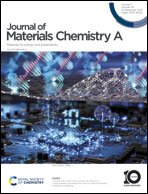The synergy between a benzoselenadiazole covalent organic framework and TEMPO for selective photocatalytic aerobic oxidation of organic sulfides†
Abstract
Covalent organic frameworks (COFs) have recently received significant attention as effective photocatalysts which rely on the selected photoactive building units. Benzoselenadiazole is one such unit that enables swift light-induced charge transfer and therefore could be used to construct COFs for photocatalytic conversions. Herein, in the presence of an organobase, 1,3,5-triformylphloroglucinol (Tp) and 4,4′-(benzoselenadiazole-4,7-diyl)dianiline (BSe) are adopted to construct a highly crystalline COF, TpBSe-COF. As designed, TpBSe-COF could implement the blue light photocatalytic conversion of organic sulfides to sulfoxides more adequately than TpDT-COF. Conspicuously, introducing the benzoselenadiazole unit into COFs can broaden the visible light absorption and accelerate electron transfer. Moreover, the synergy between TpBSe-COF and TEMPO (2,2,6,6-tetramethylpiperidine-N-oxyl) for selective photocatalysis could significantly improve the conversions of organic sulfides to sulfoxides with molecular oxygen. This work suggests the vast potential of benzoselenadiazole COFs in selective photocatalytic conversions.



 Please wait while we load your content...
Please wait while we load your content...